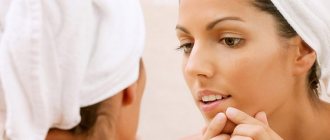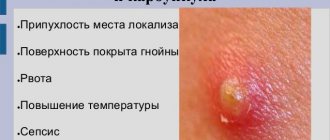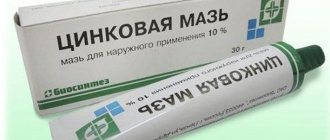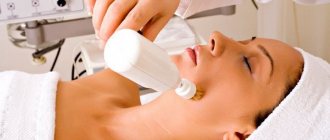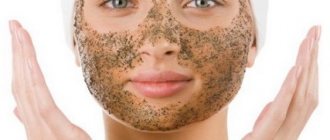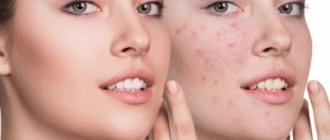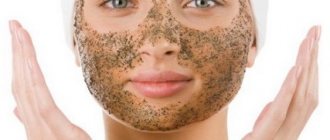Facial cleansing is a hygienic procedure that helps maintain a high level of skin quality. It is performed primarily not for beauty, but for health.
Our skin is constantly under stress. The unfavorable atmosphere of cities, overwork, poor diet, bad weather, dry indoor air, irregular or inappropriate care - under the influence of these factors, sebum production is disrupted.
Sebum is the secretion of the sebaceous glands (sebum, sebum), which consists of fatty acids and esters.
If there is too much sebum, the skin quickly becomes dirty, looks unkempt and porous. The composition of sebum also changes - it thickens, which leads to blockage of the sebaceous glands, the formation of comedones and blackheads.
Skin with clogged pores does not breathe and does not absorb nutrients. When sebum stops coming to the surface, the skin loses its protection - hello bacteria, sunburn and chapped red cheeks.
Any cleaning option helps remove excess oil and open pores.
Important tasks that cleaning solves
- Opening of pores for the delivery of cosmetic preparations into the dermis.
- Restoring the protective barrier of the epidermis by normalizing the outflow of sebum.
- Strengthening skin immunity.
- Disinfection, cleansing the skin of bacteria that cause inflammation.
- Removal of comedones (blackheads) and blackheads.
- Stimulation of lymph flow and blood flow.
Getting rid of blackheads, for which most patients go for facial cleansing, is far from the main goal of the procedure.
Peeling
All peeling products can be divided into 3 main groups according to their mechanism of action:
- Mechanical peeling (manual peeling, hardware peeling, micro-polishing);
- Physical peeling (ultrasonic peeling, laser peeling);
- Chemical peeling (based on the use of different substances).
In addition, peeling methods should be distinguished by the degree of “aggression” (depth of penetration into the skin layers):
- exfoliation, i.e. exfoliation of the stratum corneum;
- epidermolysis, i.e. superficial peeling procedure;
- medium peeling
- deep peeling
Superficial peeling
Superficial peeling affects only the upper layer of the epidermis - from horny to granular. It is recommended to prevent skin aging. Superficial peeling evens out the surface of the skin, improves the color and texture of the skin: pores narrow, wrinkles become less noticeable. In this case, only the horny cells of the epidermis are exfoliated. A peeling course consists of 5–7 procedures, the interval between which is a week. The very next day you can use cosmetics. For the procedure, fruit (alpha hydroxy) acids of varying concentrations are used, which depends on the type and condition of the skin (determined by the doctor).
Superficial peeling is the most gentle compared to medium and deep peeling. Its essence is damage, creating a burn surface on the skin. An acid of a certain concentration and strictly in time is applied to cleansed skin with a brush. The deeper the peel, the stronger the acid used and the more difficult the procedure.
Soft: the stratum corneum is destroyed to the granular layer (stratum granulosum). These include: Jessner solution, CO2, dry ice, fruit acids 20-70%, trichloroacetic acid 15%.
Superficial peeling is performed without anesthesia and is accompanied by severe redness of the skin, itching and peeling. Feeling as if someone walked over the face with a pumice stone. In the coming days, the skin begins to peel off and dry crusts appear.
At this time, the skin is treated with special products and wound-healing medications. The success of the procedure largely depends on skin care after the procedure. It is very important not to peel off the crusts and husks until they come off on their own. For a certain period of time, you should not appear in the sun, much less sunbathe, otherwise age spots will appear on your face, which are very difficult to eliminate. The remission period is 2-3 weeks.
Facial cleansing with fruit and other acids is essentially an exfoliation. These procedures are used after mechanical or hardware facial cleansing to smooth out the skin texture and remove dead cells.
If there is acne on the skin (not in the inflammatory phase!), then you can use superficial acid peeling to remove plugs from the pores. Chemical peeling with fruit acids refreshes the skin and cleanses surface impurities, but does not reach deep-lying inflammations.
In these cases, chemical peeling can only be the final stage after mechanical and other cleaning methods. The peeling procedure can be called “aggression for good.” The ability to regenerate is the most important property of the skin, without which it could not act as a barrier between the body and the external environment. The slightest breach in it can become fatal, so the reaction to damage occurs immediately. A signal for restoration work is any traumatic impact: a scratch, abrasion, burn, exfoliation of horny scales, etc.
Fruit peeling is a gentle facial cleansing that gently cleanses the skin of dead cells and toxins. Thanks to a gentle technique, this type of peeling can be used without any age restrictions, which makes it possible to prevent the formation of wrinkles at the very initial stages, improve the functioning of the sebaceous glands, the process of skin regeneration, and also stimulate the synthesis of collagen fibers, which are responsible for the elasticity and smoothness of the skin. Cosmetology specialists recommend fruit peeling for facial skin with signs of photoaging, since this procedure has not only a smoothing, but also a brightening effect. In order for the effectiveness of such peeling to be maximum, it is necessary to follow several simple rules.
The most important thing, of course, is to follow the advice of a cosmetologist who conducts a series of peeling sessions, the number of which can vary from 4 to 10 depending on the method of implementation, the concentration of the active substance and the condition of the skin. And also remember that for 30-40 days after and directly during the procedure, sunbathing is strictly contraindicated, and even better, constantly use sunscreen with a high degree of protection.
It should also be understood that such peeling does not give an immediate effect, and its positive effects appear gradually. That is, every day your facial skin will become younger and healthier. The process of gently cleansing the skin of the face itself is based on the action of AHA acids, which, due to their natural origin, are known in the same way as fruit acids. Although today these substances can also be obtained artificially, which does not make them less effective. The most commonly used are citric, glycolic, lactic, tartaric and malic acids.
Each of them has its own characteristics, but many cosmetologists believe that the best peeling is glycolic. This is explained by the fact that the molecular sizes of this acid are much smaller than others, which guarantees a deeper penetrating effect. Most specialists use a mixture of several acids.
Also, AHA acids, for a more pronounced and lasting effect, are combined with other substances, for example, vitamins A, E, salicylic acid (for deeper cleansing), etc.
The fruit peeling procedure is a seemingly simple process, but it requires specific knowledge, skills and experience. Therefore, it is better to trust its implementation to experienced professionals who have positive recommendations and characteristics.
"To go or not to go..."
Regular facial cleansing is necessary for any skin. It doesn’t matter if it’s dry or oily, with inflammation or not. The only difference is that healthy skin needs light cleansing (ultrasound or peeling), while problematic skin needs total cleansing.
Is it possible not to go for cleaning if there are no problems?
Yes, just like you can avoid going to a cosmetologist until the signs of aging appear in full force. However, it is cheaper and more effective to maintain the health and youth of unproblematic skin than to treat inflammation and eliminate noticeable wrinkles when the skin can no longer cope on its own.
Does dry skin need cleansing?
It is believed that cleansing dries out the skin, aggravating the situation, but... Dryness is accompanied by flaking, and cleansing helps remove the dead layer, so that care products are more actively absorbed into the skin. Cleaning opens the pores, which means more sebum comes to the surface, which helps restore the hydrolipid barrier - this is the most important thing for dry skin.
Causes of blackheads
Before deciding how to get rid of blackheads, it is worth understanding the reason for their appearance.
The defect can occur both due to poor health and due to external negative factors. In any case, you need to remember the reasons and the possibility of avoiding them. What causes blackheads to appear:
- Poor skin cleansing. It is important to wash off makeup thoroughly and ensure that dust and dirt do not accumulate in the pores. Otherwise, pimples and dark spots will appear.
- Hormonal imbalance. During pregnancy, menstrual periods, as well as problems with the endocrine system, sebum production increases. Because of this, the pores become clogged.
- Bad habits. If a woman smokes, it will be reflected on her face. The skin will age much faster because it reacts to carcinogens and resins. The dermis will often become inflamed.
- Excessive cleansing. If you wash and disinfect your face too thoroughly, then blackheads will also appear. Skin that is too clean will be defenseless against bacteria. The sebaceous glands will begin to produce sebum much more strongly.
- Poor quality cosmetics. Any cosmetic products must be safe for the skin. If the cosmetics are questionable, then it can lead to skin problems.
These and other reasons worsen the condition of the dermis. A woman needs to get rid of blackheads. There are different methods to deal with the problem. Some of them are more effective, and these are the ones you should take a closer look at.
Which cleaning is more effective? Depends on skin condition and type
Mechanical (also known as manual) – for oily skin prone to inflammation
How it’s done: dirt is scraped out of the pores manually using a Uno spoon or strainer.
Advantages:
- effective in the fight against acne;
- removes excess fat;
- copes with dense blockages;
- improves blood circulation.
Disadvantages: the most painful and lengthy cleaning option.
Read more about mechanical facial cleansing
Ultrasonic (aka ultrasonic cleaning) – for dry and sensitive skin
How it is carried out: contaminants are removed with an ultrasonic emitter-scrubber.
Advantages:
- cleans without damage;
- improves skin tone;
- cleanses and tightens pores;
- removes excess fat without injury;
- stops inflammation.
Disadvantages: does not cope with rashes.
Read more about ultrasonic facial cleansing
Atraumatic – for irritated and inflamed skin
How it is carried out: the skin is cleansed with a delicate peeling, then a series of care products is applied.
Advantages and features:
- does not damage the skin;
- does not irritate the skin by physical impact;
- reduces acne;
- removes pigmentation;
- tightens pores;
- evens out facial tone;
- smoothes the relief;
- can be combined with vacuum cleaning and RF lifting.
Disadvantages: Maintains skin quality, but does not treat clogged pores.
Combination – for mixed skin types with localized rashes
How it is carried out: combines mechanical and ultrasonic techniques.
Advantages and features:
- can be used for any skin type;
- less damaging to the skin compared to mechanical cleaning;
- reduces the risk of infection;
- shortens the recovery period;
- allows you to adjust the intensity of exposure in different areas.
Disadvantages: requires the experience and attention of a cosmetologist to obtain maximum effectiveness.
Read more about combined facial cleansing.
Types of salon cleaning for blackheads
The salon procedure is aimed at eliminating external contaminants: the keratinized upper layer, acne, comedones, and stimulating blood circulation. If you are interested in which facial cleansing is the most effective, then it is difficult to give a definite answer to this question. Each type has indications and contraindications. The method of eliminating blackheads should be selected by a cosmetologist after analyzing the condition of the face. But if the client himself chooses which facial cleansing is best done in the salon, it is necessary to study the features of each type of procedure.
Mechanical
This technique is especially suitable if the skin is porous and oily.
Indications for the procedure:
- comedones (white and black);
- acne without inflammation.
Contraindications:
- herpes;
- eczema;
- boils;
- rosacea;
- hypertension;
- dry, sensitive skin;
- period of menstruation.
The necessary tools are a Uno spoon (contraindicated for sensitive skin) and a Vidal needle. All instruments must be sterile, which is why the procedure should be carried out by a cosmetologist. However, despite all precautions, there is a risk of secondary infection.
Disadvantage of mechanical cleansing: high pain.
Progress of the procedure. The procedure is carried out under good lighting. The master’s task is to ensure that the pores do not close, otherwise the procedure will begin to cause serious discomfort.
When the face has steamed, the cosmetologist removes the softened horny layers without affecting the inflamed areas, and then begins deep cleaning using a Vidal needle and an Uno spoon. Afterwards, the skin is disinfected with infrared light, a liquid with anti-inflammatory properties, such as hydrogen peroxide, and also applying masks with a calming effect. Cryomassage is recommended.
The duration of the procedure is about 20 minutes, after which the pores close on their own. Further cleaning becomes painful, so either a new steaming compress is made or the procedure is postponed to another session.
Mechanical cleansing is considered an outdated technique, but it allows you to thoroughly clean your face when hardware methods fail. It is used as a complement after other types of cleansing.
Vacuum
To carry out the procedure with a vacuum, you need a suction cup tool, which, under the influence of negative pressure, sucks in the contents of the pores. The appropriate attachment is selected according to the client's skin type. This procedure rarely injures the epidermis and does not cause pain or recurrence of inflammation. However, sensitive skin may experience bruising.
The indications are the same as for mechanical facial cleansing.
Contraindications:
- inflamed acne;
- rosacea;
- dermatitis;
- dry, sensitive skin.
The vacuum method of facial cleansing will not help with deep, old blackheads, so it is complemented by regular manual or mechanical cleansing.
Progress of the procedure. The suction cup moves around the surface of the face in a circle. From time to time, the instrument is sterilized in antiseptic. As a result of these actions, blood circulation improves, the skin becomes more toned, acquires a healthy color, and lymphatic drainage improves.
Note! Cleansing is carried out only after steaming.
After the procedure, the pores are closed by applying soothing agents.
Duration – 15-20 minutes.
Home vacuum devices are available. However, they are inferior to professional devices in terms of functionality and efficiency.
Laser
This is not exactly cleaning if you compare the technique with other options. However, thanks to laser treatment, regeneration processes are launched in the skin and its outer layers are renewed.
Indications for the procedure are:
- pimples with and without heads;
- comedones;
- acne;
- enlarged pores.
Contraindications include:
- exacerbation of acne;
- menstruation period;
- allergy to laser;
- herpes;
- diabetes;
- neoplasms.
This is a complex procedure. Its essence is that the laser “evaporates” the upper layers of the epidermis, as a result of which the outer layer of cells is then renewed. While some types of procedures can be carried out at home, laser cleaning at home is contraindicated. It must be performed by a specially trained cosmetologist.
Progress of the procedure. Before treatment, an anesthetic cream is applied. And then they begin to cauterize the skin with a laser with a working surface of 1.5x1.5 cm.
The duration is from 20 minutes to 1 hour. Laser cleaning should not be overused; it is carried out once a month, or even less often.
Galvanic
As the name suggests, a galvanic current is applied to the face during the cleansing process. The procedure is painless as a weak current is used. In rare cases, it is felt as a tolerable tingling sensation, and in some cases it is not felt at all.
This is a highly effective procedure that can get rid of deep, old stains, so it is recommended instead of manual cleaning as it is less traumatic. Thanks to electricity, sebaceous plugs dissolve and are brought to the surface, sebum turns into soap, which is removed by a cosmetologist after the procedure.
Indications:
- increased fat content;
- acne and comedones;
- post-acne;
- wrinkles;
- seborrhea.
Contraindications:
- dryness and sensitivity;
- pregnancy;
- vitiligo;
- neoplasms;
- dermatitis;
- presence of pacemakers and electrical implants.
Note! As a result of galvanic cleaning, impurities are removed, blood vessels are strengthened, tone is increased, blood flow and metabolism are stimulated.
Progress of the procedure. A conductive gel is applied to the face. Then the cosmetologist takes a device equipped with an attachment with electrodes. He moves this attachment over the surface of the face in a circular motion. If you use any cosmetic medicinal preparations together with galvanic cleaning, then under the influence of electric current they penetrate much deeper than usual.
After the procedure, the relief is evened out, so the effect is comparable to peeling. There is no need to close the pores, just remove dirt and apply your usual care products.
Duration of procedure: 20 min.
Depending on the frequency of galvanic cleaning, different effects may be observed. If you carry out the procedure no more than once a month, the skin will dry out, which is optimal for high oil content. But if the procedures are abused, sebum is produced more intensely.
Cleansing your facial skin at home and at a cosmetologist: what’s the difference?
Salon procedure: pros and cons
Pros:
- Compliance with aseptic conditions during the procedure.
- Effective and safe methods for opening pores.
- Use of devices for atraumatic cleaning.
- Possibility of combining methods to achieve better results.
- Proven professional care products.
Minuses:
- The need to pay for the procedure.
- Difficulties with choosing a cosmetologist.
Home procedure: pros and cons
Pros:
- There are no financial or time restrictions.
- Full control of the composition and progress of the procedure.
Minuses:
- Risk of infection.
- The need to spend money on skincare products.
- Inability to use hardware techniques.
In these cases, cleaning cannot be done!
- When taking systemic retinoids - drugs based on isotretinoin, which suppresses the activity of the sebaceous glands. Cleaning can be done 21 days after the end of the course.
- For manifestations of retinoid dermatitis (from the use of external retinoids in the form of ointments and gels). If there is no skin irritation, only when 4-5 days have passed after using the drug.
- Within 14 days after a chemical peel . The skin must be completely restored before cleansing.
- During a course of daily acid-based care . If you use acids constantly and your skin is used to them, then you can do cleansing. If products containing acids were recently prescribed by a cosmetologist for treatment, then cleaning is not recommended.
- If there are a large number of papules and pustules . During cleaning, a cosmetologist can open single closed-type formations, but if there are many of them, then it is better to use drug therapy, a laser or a course of peelings than to extensively injure the skin by opening foci of inflammation.
- During exacerbation of rosacea . In this case, cleaning is not recommended due to the risk of injuring the vessels.
Is cleansing compatible with the use of acne medications?
Drug treatment of acne is aimed at influencing the main links of pathogenesis - inflammation, colonization of propionibacteria, hyperkeratosis, increased sebum production. It helps reduce the number of comedones and tighten pores. But the first results from the use of medications, as a rule, become noticeable only after a few weeks (for example, for the drug Clindovit® this period is 6-8 weeks).
In this sense, high-quality skin cleansing gives faster and more visible results. But the results of the procedure in themselves are unstable; they can only be prolonged in combination with drug treatment. In order to safely combine external drug treatment and procedures aimed at cleansing pores, the course of therapy must be drawn up by a doctor. If a patient visits two specialists - a dermatologist and a cosmetologist, their appointments must be agreed upon.
Even more inflammation after cleansing: two reasons
- Infection during the procedure
Facial cleansing should be performed in a treatment room where aseptic and antiseptic standards are observed. This is especially important for mechanical cleaning, which disturbs the skin.
- The cosmetologist must work in a cap, mask and sterile gloves. The mere presence of gloves does not equal sterility. Gloves should be removed from the sealed packaging in front of the patient at the beginning of the procedure.
- Instruments must be sterilized after each patient.
- The office must be disinfected after each patient.
- A cosmetologist should have alcohol wipes in his arsenal. After opening each source of inflammation, the skin and instruments should be treated with an antiseptic.
If these measures are not followed, then bacteria from one pimple or from the hands of a cosmetologist can spread throughout all freshly cleaned pores and cause widespread inflammation.
- Infection after the procedure
Most often, the infection is introduced into wounds and pores by the hands of a patient who can’t wait to touch his renewed face.
In the first 8 hours after cleansing, you should not wash or touch the skin, as it needs to restore the protective barrier - this is a mandatory recommendation that every cosmetologist gives at the end of the appointment.
To prevent skin inflammation after cleansing, follow the care recommendations and trust the procedure only to certified clinics.
Should I look for a remedy for comedones at the pharmacy?
Blackheads are open comedones. If, along with them, there are other acne elements on the face, then it’s time to contact a dermatologist. The specialist will select an effective remedy and procedures for acne on the face, and will also prescribe topical or systemic (depending on the degree of acne) medications to eliminate acne.
Clindovit® is a topical antibiotic6. It contains clindamycin phosphate, which, after application to the skin, hydrolyzes to form clindamycin6. This lincosamide antibiotic exhibits antibacterial activity against Propionibacterium acnes6. The drug helps reduce the level of fatty acids on the skin6. To reduce the risk of antibiotic resistance, Clindovit® is recommended to be combined with benzoyl peroxide or azelaic acid (Azelik®)28.
How to care for your facial skin after cleansing
What you can do:
- use alcohol-free toners to soothe the skin after cleansing and remove excess sebum, the production of which is temporarily accelerated after the procedure;
- Apply light moisturizers and serums to prevent flaking.
What not to do:
- touch your face in the first 12 hours after the procedure;
- apply decorative cosmetics on the first day;
- visit the pool, sauna and solarium in the first 3 days;
- use scrubs and peels in the first 5-7 days.
How to properly carry out daily cleansing: instructions
Facial cleansing is the longest and most important skin care procedure that is performed at home and depends on you. It consists of several basic stages.
Preparation or makeup removal
The stage of removing surface impurities that have accumulated on the surface of the skin during the day or night.
Many people neglect morning cleansing, believing that the epidermis did not have time to get dirty overnight. While we sleep, the body's metabolic processes are continuously working, internal cleansing and cell restoration occur. For example, the peak of sebum production occurs at 4–5 o'clock in the morning, so it is important to take care of cleansing the facial skin twice a day (more often it is not recommended so as not to damage the hydrolipid mantle).
The following products are suitable for makeup removal:
- micellar water (for all skin types);
- milk (for dry and sensitive types);
- cleansing lotion (often does not require rinsing with water);
- Makeup remover wipes (travel version).
Washing (basic cleansing)
The second step is to wash your face with water and cleanser. At this stage, you need to cleanse the facial skin of any remaining impurities dissolved in the first stage and completely empty the pores.
There are special products for washing:
- for oily and combination skin – foams with a sebum-regulating effect, facial gels + “2 in 1” scrub;
- for sensitive people – soft mousses, foams;
- for dry and dehydrated skin – moisturizing and softening milk, cream, balm.
Apply a small amount of product to damp facial skin. Then use gentle circular movements with your fingertips to massage the entire surface of your face, avoiding the eye area. Finally, rinse off the cleanser with water and pat your face dry with a clean, soft towel.
Moisturizing and toning
The final, but not the last most important stage of cleansing is skin moisturizing. After washing your face, wipe your dry face with a cotton pad soaked in a toner with a moisturizing formula. This will restore the pH balance of the epidermis, prepare for the further corrective stage of care and improve the penetration of beneficial components from care cosmetics into the deep layers of the skin.
